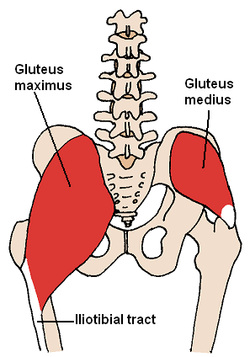Gluteus Medius
Original Editor - Alex Palmer,
Top Contributors - Alex Palmer, George Prudden, Kim Jackson, Ahmed Nasr, Joao Costa, Joanne Garvey, Candace Goh, Nupur Smit Shah, WikiSysop, Vidya Acharya, Pinar Kisacik, Rachael Lowe, Evan Thomas and Kai A. Sigel;
Description[edit | edit source]
Gluteus medius is located on lateral aspect of the upper buttock, below the iliac crest. The superior muscle is broad with the muscle narrowing towards its insertional tendon giving it a fan-shape. Posteriorly, the muscle is overlapped by the gluteus maximus. Gluteus medius is an important muscle in walking, running and single leg weight-bearing.[1] Weakness in this muscle has been associated with lower-limb musculoskeletal pathology[2] and gait disturbance following stroke.[3]
Anatomy[edit | edit source]
Origin[edit | edit source]
Gluteal, or lateral surface of the ilium between the posterior and anterior gluteal lines. This is a large area, reaching from the iliac crest above to the almost the sciatic notch below.[1]
Insertion
[edit | edit source]
Posterior fibres pass forwards and downwards, the middle fibres downwards, anterior fibres pass backwards and downwards. Fibres combine to form a flatterned tendon which attaches to the superlateral side of the greater trochanter of the femur.[1]
Nerve supply[edit | edit source]
The gluteus medius is supplied by the superior gluteal nerve (root L4, 5 and S1). Cutaneous supply is mainly provided by L1 and 2.[1]
Blood Supply[edit | edit source]
Superior gluteal artery and superior gluteal vein.
Function[edit | edit source]
The gluteus medius and minimus are strong abductors and medial rotators of the hip joint.[4] A contraction of the anterior fibers results in flexion and inward rotation and a contraction of the posterior fibers results in extension and external rotation.[5] Altogether they play an important role in the stabilization of the pelvis. Abnormality of this muscle can cause Trendelenburg’s sign.
Tears in the gluteus medius and minimus tendons, often misdiagnosed as trochanteric bursitis, have recently emerged as an important cause of recalcitrant greater trochanter pain syndrome. Advances in endoscopic surgery of the hip have created opportunities to better evaluate and treat pathology in the peritrochanteric compartment.[6] [7]
Assessment[edit | edit source]
Palpation[edit | edit source]
Find the centre of the iliac crest (directly above the greater trochanter of the femur) and palpate inferiorly two fingers breadth to find the bulk of the muscle.[8] To isolate in function, stand alternatively on one limb and then the other, feeling the muscle contract as you weight-bear through that limb.[8] The muscles will contract alternatively during walking, switching on during stance phase to stabilise the pelvis.
Power[edit | edit source]
Length[edit | edit source]
Resourses[edit | edit source]
See also[edit | edit source]
Greater trochanteric pain syndrone
Recent Related Research (from Pubmed)[edit | edit source]
References[edit | edit source]
- ↑ 1.0 1.1 1.2 1.3 Palastanga N, Soames R. Anatomy and Human Movement: Structure and Function. 6th ed. London, United Kingdom: Churchill Livingstone; 2012.
- ↑ Barton CJ, Lack S, Malliaras P, Morrissey D. Gluteal muscle activity and patellofemoral pain syndrome: a systematic review. British journal of sports medicine. 2012 Sep 3:bjsports-2012.
- ↑ Buurke JH, Nene AV, Kwakkel G, Erren-Wolters V, IJzerman MJ, Hermens HJ. Recovery of gait after stroke: what changes?. Neurorehabilitation and Neural Repair. 2008 Nov 1;22(6):676-83.
- ↑ Cite error: Invalid
<ref>tag; no text was provided for refs namedDrake et al, 2010 - ↑ Gowda AL, Mease SJ, Donatelli R, Zelicof S. Gluteus medius strengthening and the use of the Donatelli Drop Leg Test in the athlete. Physical Therapy in Sport 2014; 15(1) 15-19.
- ↑ Domb BG1, Nasser RM, Botser IB.Partial-thickness tears of the gluteus medius: rationale and technique for trans-tendinous endoscopic repair.Arthroscopy. 2010 Dec;26(12):1697-705
- ↑ El-Husseiny M1, Patel S, Rayan F, Haddad F.Gluteus medius tears: an under-diagnosed pathology.Br J Hosp Med (Lond). 2011 Jan;72(1):12-6.
- ↑ 8.0 8.1 Cite error: Invalid
<ref>tag; no text was provided for refs namedPalastanga et al, 2002







